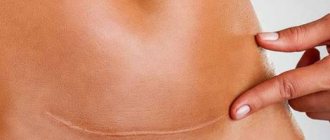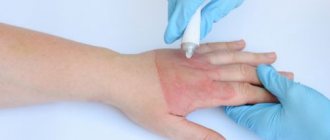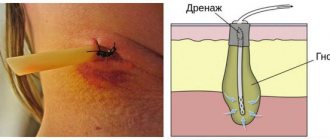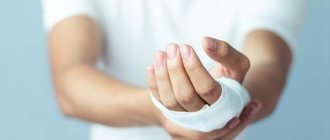Scarring
Healing of a granulating wound occurs through scarring and epithelization. At the final stage of healing, collagen fibers appear among the cells of the granulating tissue, the number of granules decreases, and the number of fibers increases. Ultimately, the fibrous substance passes into the connective tissue and forms a scar.
When wounds heal by primary intention, delicate scar tissue is formed, which tends to resolve.
In case of healing by secondary intention, a rough scar is formed, which will not be easy to get rid of.
Types of wound healing
According to the classification of I.V. Davydkovsky, the following types of wound healing are distinguished:
- closing the defect of the epithelial cover, which occurs when the upper epithelial layer is damaged;
- healing under a scab, or healing without a scar. Observed on mucous membranes in case of minor defects.
- healing by primary intention, or healing without suppuration. Characteristic of wounds with damage to the skin and tissue underneath.
- healing by secondary intention, or healing through suppuration and granulation. Occurs with extensive wounds, accompanied by foreign objects entering the wound, tissue necrosis, microbes and infections.
What types of wounds are there?
The healing process and time of damage largely depend on its type. Wounds, according to the factors that caused them, are divided into the following types:
- puncture wounds are injuries caused by a thin object pointed at the end (an awl, a knitting needle), which are distinguished by significant depth in relation to width. In the vast majority of cases, puncture wounds practically do not bleed and this can cause a dangerous misconception that they are not dangerous and, as a result, late seeking medical help. In fact, with a stab wound, damage to internal organs is often observed, as well as internal bleeding, often intense. In this case, blood accumulates, for example, in the abdominal cavity. A narrow wound channel blocks the access of oxygen to the damaged surface, which becomes fertile ground for the development of extremely dangerous gangrenous bacteria;
- incised wounds are injuries caused by a narrow, pointed object. They can also penetrate to a considerable depth, but, unlike stab wounds, they bleed much more, since in the process of inflicting such a wound a large number of blood vessels are damaged. The edges of such a wound are smooth;
- chopped wounds are injuries inflicted by a heavy pointed object (axe, shovel). The edges are often uneven, crushed, the wounds are usually deep;
- lacerations - usually occur with intense mechanical impact on a large area of skin. The edges are uneven, often the skin peels off from the underlying tissues with the formation of a scalped wound, and intense bleeding is not uncommon;
- Bite wounds are wounds that occur as a result of the impact of the teeth of an animal or a person on the body. On the teeth, as a rule, there is plaque with specific microorganisms, which often provoke significant inflammation in the wound;
- Contusion wounds are wounds caused by blunt force trauma. The skin and underlying tissues in the damaged area often become dead. Bleeding is usually minor, interstitial with the formation of a hematoma;
- A gunshot wound is a wound caused by a firearm. It is characterized by significant damage to the tissue around the wound channel due to the impact of bullet energy on them, as well as the presence of particles of clothing and gunpowder in the channel;
- burn wounds are wounds caused by exposure of the skin to thermal energy or concentrated alkalis/acids. The intensity of damage to the skin and underlying tissue depends on the severity of the burn.
Stages of healing
The wound healing process goes through three main stages: inflammation, regeneration, and restoration of the epithelium.
The inflammation phase begins immediately after injury and in an uncomplicated state lasts for 4–5 days. During the hemostasis stage, platelets attach to sites of injury and cause a chemical reaction that activates fibrin, which forms a matrix network and binds platelets to each other. This is how blood clots form, blocking damaged blood vessels and stopping bleeding.
At the stage of proliferation and regeneration, the process of angiogenesis, collagen deposition, and the formation of granulation tissue (young connective tissue formed in places of defects) occurs. The regeneration stage can last 2–4 weeks depending on the size of the defect.
The final stage is the formation of the epithelium. Depending on the severity of the injury, the process can last from several weeks to a year or more.
Possible complications and what to do about it
Problems may arise if the condition is neglected.
Possible consequences:
- Serroma is the formation of exudate in the cavity. The wound cavity will not heal. With secondary infection, suppuration begins.
- A hematoma develops when measures to stop bleeding are ineffective. The blood compresses the tissues, causing their necrosis. It is an ideal environment for the propagation of pathogenic flora. The wound, sewn up long ago, begins to fester.
- Necrosis occurs due to irregularities in suturing. The tissues do not receive nutrients, swell and die. Excision is indicated due to the risk of sepsis.
- Abscess and phlegmon appear when a secondary infection occurs. Often pathologies are a consequence of the patient’s reluctance to go to the emergency room in a timely manner.
- The divergence of the edges occurs due to carelessness after removing the seams. Treatment is only surgical.
- Malignization occurs with a long-term inflammatory process and lack of epithelization in a timely manner.
All conditions are accompanied by pain, swelling, and hyperemia of nearby tissues. When sepsis occurs, the temperature rises to pyretic values, a decrease in pressure, and dehydration are observed. If symptoms appear, you should immediately contact a medical facility. The surgeon will have to re-treat the sutured wound and prescribe antibiotic therapy.
Wound treatment
The choice of wound treatment method largely depends on their type (infected or necrotic, wet exuding or fibrous granulating, trophic ulcers or bedsores). Only a doctor can choose the optimal solution for treating each type of wound.
In addition, at each stage of wound healing, it is necessary to use a different agent: one that promotes the removal of exudate, the formation of granulation tissue, accelerating epithelization, etc.
When treating wounds, you need to remember that the wound does not heal on its own, but thanks to the body’s resources aimed at healing it. The immune, endocrine, and circulatory systems are involved in this process. A qualified doctor, along with treating the wound itself, will definitely prescribe a vitamin complex to maintain the body.
Treatment of injured areas in the granulation phase
At an early stage, granulation tissue is very thin and delicate and is easily injured. This requires adherence to certain rules that can be used to achieve rapid wound healing and preserve granulation tissue for as long as possible.
Absolutely forbidden:
- Wipe the wound, scraping the top layer with cotton pads - the wound is treated only with warm disinfectant solutions, with minimal contact with the wound surface. Cotton wool particles can get into the wound, which can worsen inflammation and cause delayed regeneration of damaged cells.
- Tearing off a bandage that adheres to a wound—the granulation layer is torn off along with the bandage, which slows down the regeneration of damaged areas tenfold. Before applying a bandage, it should be soaked in a disinfectant solution to facilitate its removal from the wound.
- Combing and tearing off crusts formed on the wound surface.
When the wounds are granular, tearing off the projectiles is strictly prohibited.
In the granulation phase, there are three types of wound treatment: therapeutic, physiotherapeutic and traditional methods. All of them are selected individually, taking into account the specifics of the wounds.
Drug treatment
The use of topical wound healing agents promotes faster scar formation. Such drugs have bactericidal properties, reducing the risk of pathogenic microorganisms entering the bloodstream through a wound.
The most effective drugs for wound granulation are:
- Bepanten-Plus (Panthenol, Dexpanthenol) - in addition to the active regeneration process, the drug has a bactericidal effect due to the content of chlorhexidine. It has a thick consistency that protects the wound surface from the penetration of pathogenic microorganisms. It can be used both under a dressing and openly.
- Methyluracil ointment - normalizes the metabolism of nucleic acids in cells, which accelerates the regeneration process by increasing the metabolic rate. The active ingredients act locally without penetrating into the blood. Suitable for treating patchy and non-healing wounds for a long time.
- Solcoseryl - improves local blood circulation, which helps accelerate the formation of new cells. The consistency of the gel allows you to apply the drug in a thin layer, which is more than enough to prevent the development of inflammation.
Methyluracil ointment is one of the drugs used to treat wounds.
Ointments, creams and gels are applied only to a previously cleaned wound surface. For preliminary disinfection, use hydrogen peroxide, furatsilin solution, iodicerin. Before applying the cream, pat the wound dry with a sterile bandage.
The wound is bandaged at least 3 times a day. If a bandage is used, it should be pre-wetted and then removed along with the scab. It is recommended to let the wound dry before applying ointments and creams.
In cases where the wound is very painful, painkillers can be used:
- Non-steroidal anti-inflammatory drugs - have antipyretic, anti-edematous and anti-inflammatory effects. Has an analgesic effect for up to 5 hours. Used for shallow wounds.
- Complex painkillers - relieve pain, as well as other unpleasant symptoms.
- Opioid painkillers - used for large and deep wounds. They block the pain centers of the brain.
An integrated approach to treatment brings the best results. It is strictly forbidden to use drugs without consulting a doctor, as some of them have side effects and can provoke the development of allergies.
Physiotherapeutic procedures
With their help, you can speed up the regeneration of damaged cells, as well as reduce the likelihood of penetration of pathogenic microflora. The most effective of them are:
- UHF - exposure to ultraviolet radiation has a beneficial effect on the condition of the wound. The rays destroy germs and also help skin cells grow faster.
- Magnetic therapy - irradiation with magnetic rays accelerates the formation of granulation tissue, and also makes the scar flatter, smoother and stronger.
Magnetic therapy accelerates wound granulation
Physiotherapeutic procedures are indicated when the wound is healing poorly, a purulent scab has long formed, and its edges are inflamed. In most cases, small wounds can be healed without physical therapy. This method of treatment is indicated for extensive lesions, the presence of immunodeficiencies, as well as pathologically reduced local immunity.
Traditional methods of treatment
Self-treatment with alternative medical methods is recommended only when the wound is shallow, small, flat and not infected. In this case, you can resort to the following wound healing methods:
- Herbal compress - for a glass of boiling water, take 1 teaspoon of oak bark, sage and nettle, and 1 tablespoon of eucalyptus. Boil in a thermos for 3-4 hours, then strain. Add 1 teaspoon of sea salt to the broth, then apply to the surface of the wound for 2-3 hours.
- Solution for disinfecting wounds - 1 teaspoon of sage, thyme oil, mother oil, 2 teaspoons of nettle leaves, 3 drops of tea tree essential oil. The herbs are boiled in a water bath for 10 minutes, allowed to cool, then strain and add tea tree essential oil. The resulting broth is drawn into a syringe and watered 5-8 times a day.
- Lamb fat ointment - take 25 g of belly fat and melt it in a water bath until liquid, then add 6 drops of lavender oil, 3 drops of eucalyptus oil, 2 drops of tea tree oil. Mix well and place in a jar, allowing it to cool to room temperature. Apply a thin layer to the wound, touching its edges.
Ointment based on sheep fat - a folk way to accelerate the granulation of wounds
It is not recommended to use these recipes if:
- the wound constantly bleeds and hurts a lot
- the edges around the wound become inflamed, painful and itchy;
- the wound does not heal for a long time;
- purulent plugs and unpleasant odor.
Any wounds that do not heal in more than 5 days should be examined by a specialist. For various reasons, the regeneration process is difficult, which is extremely dangerous for the entire body.
If the granulation process is delayed, the wound may rot, jeopardizing the health of the entire body. This requires a surgical procedure to remove the affected and necrotic areas of skin. Further treatment requires the use of antibiotics to eliminate pathogens.
How to speed up healing
The speed of wound healing varies. It depends on the nature of the injury and the individual characteristics of the patient, such as age, nutrition, and medications taken.
To speed up healing, it is necessary to provide optimal conditions for tissue regeneration at each stage. This role is fulfilled by therapeutic dressings designed for each stage of healing.
The method of hydrotherapy has a positive effect. Its essence consists in the sequential use of two dressings HydroClean and HydroTac. Using the first, the wound is cleaned, and then a second is applied, creating optimal conditions for granulation and epithelization.
Products for treating sutured wounds
The treatment consists of 2 stages - cleaning the skin adjacent to the scar. The epidermis is cleaned with a soap solution and hydrogen peroxide. It is necessary to avoid contact with liquid on the damaged area. After manipulation, a sterile bandage is applied to the sutured wound.
Do not touch or pull the threads that tighten the seams and knots. There is a risk of injury and divergence of the skin edges.
Antiseptics used during processing:
- Hypertonic solution or sodium chloride with a concentration of 10%. For external use only. The drug has a detoxifying, disinfecting, drying effect. There are no contraindications.
- Potassium permanganate solution. The crystals need to be dissolved in boiled water. The color of the liquid should be pale pink. The drug has an antiseptic, drying effect. Avoid contact with eyes, do not use high concentrations, as this may cause burns and a low rate of tissue regeneration.
- Hydrogen peroxide. The drug softens and removes remaining pus and blood. Does not have a bactericidal effect. Apply using a gauze pad. Blasting is allowed. After the release of oxygen ceases, the sutured wound should be dried with a cotton swab.
- Brilliant green has antibacterial and fungicidal effects. Does not relieve inflammation and does not irritate the epidermis. The product is applied to a previously cleaned seam using a cotton swab. The drug is incompatible with iodine and alkaline solutions. May burn after application.
- Chlorhexidine is a ready-made solution for external treatment of tissues. Has an antibacterial effect, is not active against fungal flora. Apply in a stream. The medicine is incompatible with soap and alkaline solutions.
- Miramistin is a ready-made solution. Active against pathogenic and fungal flora. Apply using a cotton swab or jet.
- Betadine based on povidone-iodine. Acts on bacteria, fungi, viruses and protozoan microorganisms. Apply to the seam using a cotton swab. The product should not be used for diseases of the thyroid gland, imbalance of thyroid hormones, or in early childhood.
There is a wide selection of antiseptics on the shelves of pharmacies, from expensive to budget ones. You should buy the drug recommended by the doctor based on the patient’s condition and medical history.
What to do if the wound does not heal
Non-healing or chronic are wounds that do not respond adequately to therapy despite prolonged treatment. Such wounds are usually caused not by external factors, but by reasons hidden inside the body, leading to disruption of metabolic processes and, as a consequence, disruption of the wound healing process. This category includes trophic ulcers, bedsores, and diabetic foot ulcers. Before using any dressings, consult a doctor: therapy and treatment of wounds can only be prescribed to you by a doctor!
For the treatment of chronic wounds, HARTMANN has developed a two-bandage system - HydroClean Plus and HydroTac.
The HydroClean Plus cleansing dressing can be used at all stages of wound healing, effectively removing necrotic tissue and pathogenic bacteria from the wound surface. They get caught in the absorbent layer and die under the influence of the antiseptic. The HydroTac dressing has absorbent and moisturizing properties and also protects the wound from secondary infection.
With the help of the hydrotherapy system, many patients have been able to significantly alleviate suffering and improve their quality of life.
Causes of non-healing wounds
The immediate cause of non-healing wounds is insufficient activity of restoration processes in the body, slow tissue regeneration. Moreover, the conditions under which regeneration slows down can be varied.
Among the general factors (i.e., affecting the state of the body as a whole), the following can be identified:
• weakened immunity due to concomitant disease or chronic immunodeficiency state;
• chronic intoxication of the body;
• metabolic disease;
• diabetes; this condition can be considered a severe form of metabolic disorder, namely glucose metabolism. Disturbances in the normal absorption of glucose lead to increased tissue fragility and a slowdown in the regeneration process;
• circulatory disorders - both general and local. The cause may be atherosclerosis, deformation of vascular walls, and diseases of the cardiovascular system. Local circulatory disorders can be caused by prolonged compression of tissues and pinching of small blood vessels (an example of a chronic wound against the background of constant compression of tissues - bedsores);
• hypo- or avitaminosis of vitamins A, C, K and group B, which play an important role in the process of tissue regeneration;
• lack of calcium or zinc in the body;
• exhaustion – nutritional (due to insufficient or malnutrition) or senile;
• presence of cancer.
A specific factor in the appearance of chronic wounds is poor circulation in the legs, most often due to varicose veins. Against the background of impaired blood circulation, trophic ulcers develop on the legs (usually in the shins) - difficult-to-heal tissue defects.
Local factors affecting the wound itself and the area around it include:
• infection;
• the presence of necrotic tissue in the wound (they increase the risk of suppuration and, accordingly, the duration of healing);
• presence of foreign bodies in the wound;
• the presence of bleeding in the wound (also increases the risk of infection);
• repeated damage to an unhealed wound.
The risk of a wound becoming chronic increases if, in addition to the skin, other tissues are damaged - subcutaneous tissue, nerves, muscles, tendons, bones.








